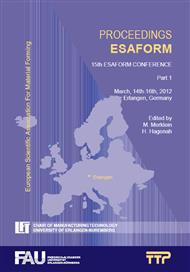[1]
S.P. Keeler and W.A. Backofen, Plastic instability and fracture in sheets stretched over rigid punches, ASM Trans. 56 (1963) 25-48.
Google Scholar
[2]
G.M. Goodwin, Application of strain analysis to sheet metal forming problems in the press shop, SAE Automotive Engineering Congress, (1968) paper no. 680093.
DOI: 10.4271/680093
Google Scholar
[3]
R. Hill, On discontinuous plastic states, with special reference to localized necking in thin sheets, J. Mech. Phys. Solids 1 (1952) 19–30.
DOI: 10.1016/0022-5096(52)90003-3
Google Scholar
[4]
H.W. Swift, Plastic instability under plane stress, J. Mech. Phys. Solids 1 (1952) 1–18.
Google Scholar
[5]
Z. Marciniak and K. Kuczynski, Limit strains in the processes of stretch forming sheet metal, Int. J. Mech. Sci. 9 (1967) 609–612.
Google Scholar
[6]
D. Banabic, Sheet Metal Forming Processes. Constitutive modelling and numerical simulation, Springer, Heidelberg, Berlin, (2010).
Google Scholar
[7]
D. Banabic, E. Dannenmann, The influence of the yield locus shape on the limits strains, J. Mat. Process. Technol. 109 (2001) 9-12.
Google Scholar
[8]
S. Ahmadi, A.R. Eivani, A. Akbarzadeh, An experimental and theoretical study on the prediction of forming limit diagrams using new BBC yield criteria and M–K analysis, Computational Materials Science 44 (2009) 1272-1280.
DOI: 10.1016/j.commatsci.2008.08.013
Google Scholar
[9]
D. Banabic, F. Barlat, O. Cazacu, T. Kuwabara, Advances in anisotropy and formability, International Journal of Material Forming 3 (2010) 165-189.
DOI: 10.1007/s12289-010-0992-9
Google Scholar
[10]
R. Hill, The mathematical theory of plasticity, Clarendon Press, Oxford, (1950).
Google Scholar
[11]
R. Hill, Theoretical plasticity of textured aggregates, Math. Proc. Cambridge Phil. Soc. 85 (1979) 179-191.
DOI: 10.1017/s0305004100055596
Google Scholar
[12]
R. Hill, Constitutive modelling of orthotropic plasticity in sheet metals, J. Mech. Phys. Solids 38 (1990) 405-417.
DOI: 10.1016/0022-5096(90)90006-p
Google Scholar
[13]
W.F. Hosford, On yield loci of anisotropic cubic metals, Proc. 7th North American Metalworking Conference, Dearborn (1979) 191-197.
Google Scholar
[14]
F. Barlat, J. Lian, Plastic behaviour and stretchability of sheet metals. Part I: A Yield Function for Orthotropic Sheets under Plane Stress Conditions, Int. J. Plasticity 5 (1989) 51-66.
DOI: 10.1016/0749-6419(89)90019-3
Google Scholar
[15]
A.P. Karafillis, M.C. Boyce, A general anisotropic yield criterion using bounds and a transformation weighting tensor, J. Mech. Phys. Solids 41(1993) 1859-1886.
DOI: 10.1016/0022-5096(93)90073-o
Google Scholar
[16]
F. Barlat et al., Plane stress yield function for aluminium alloy sheets – Part 1: Theory, Int. J. Plasticity 19 (2003) 297–319.
Google Scholar
[17]
D. Banabic et al., An improved analytical description of orthotropy in metallic sheets, Int. J. Plasticity 21 (2005) 493–512.
DOI: 10.1016/j.ijplas.2004.04.003
Google Scholar
[18]
O. Cazacu, F. Barlat, Generalization of Drucker's yield criterion in orthotropy, Mathematics and Mechanics of Solids 6 (2001) 613–630.
DOI: 10.1177/108128650100600603
Google Scholar


